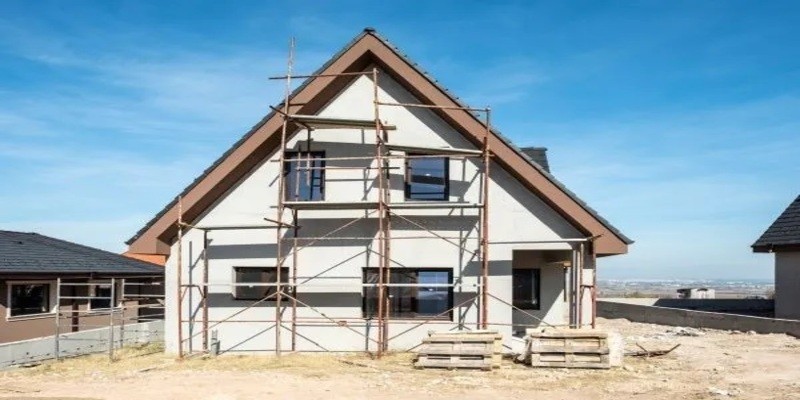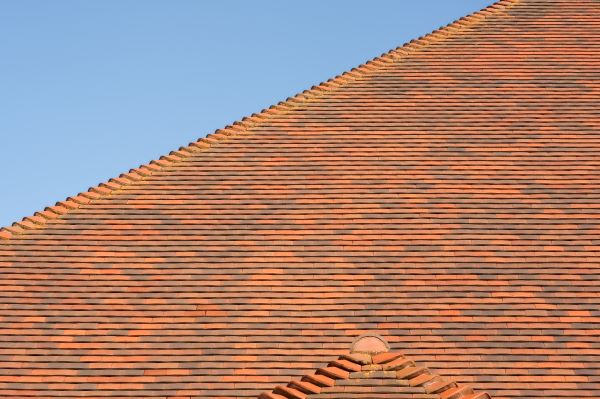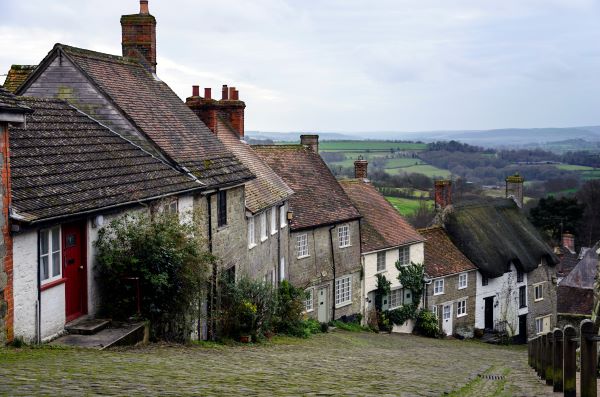Why Does Roof Pitch Matter?

The roof pitch is the steepness of the roof and when designing a building there’s several factors that go into deciding what pitch the roof will be. First and foremost, it needs to suit the weather conditions of the local area.
Different roof pitches are suitable for different climates, a flat roof cannot withstand heavy rain or snow conditions as well as a pitched roof can, and might even buckle under the weight of a heavy snowfall. In countries outside of the UK there have been reports of roofs collapsing and causing fatalities after a spell of particularly bad weather. In the UK we’re lucky that we don’t often experience extreme weather conditions, but, nonetheless, if the wrong roof pitch is used this can still lead to damage to the roof and/or the building.
Flat Roofing
Even a flat roof needs to have a pitch of some degree (a minimum of 1° in fact) to make sure that rainwater runs off the roof efficiently and does not accumulate and pool on top.
A roof is still considered a flat roof if it has an angle between 1° and 10° and even though they aren’t suitable for all buildings they are a popular choice for extensions, porches and garages.
Their main selling point is their low price point, they’re much more cost effective and easier to install than a pitched roof. They can also often be installed by a keen DIY'er meaning there’s no need to spend out on an expensive contractor. Maintenance for a flat roof is also often cheaper, although it can be required more regularly than a pitched roof.
A flat roof, if reinforced accordingly, also gives you the option to utilize the extra space on the roof. Many architects are now using a flat roof to extend a first-floor room or to give the residents the option of a roof garden if there is no space for a conventional garden.
People are becoming increasingly eco – conscious and using a flat roof to have a green roof by laying sedums using trays or rolls of grass.
However, their disadvantages include their unsuitability for all climates and their tendency to have pooling water if the angle is not right. Pooling rainwater along with silt, leaves and other debris that can build up on a roof with it can become heavy quickly. It can lead to mould, leaks and wall cracks within the building and even the buckling of the roof itself.
Flat roofing is also renowned to have a shorter lifespan than pitched roofing material. Although, in the last few years there have been major developments in the longevity of a flat roof, for example this Classic Bond Flat Roof Rubber Membrane has a life expectancy of 50 years!

Pitched Roofing
On the flip side, a pitched roof is far more effective at dealing with rainwater and snow, diverting it quickly and easily off the roof and away from the house meaning that there is no risk of any damage from the rain or potential pooling. For this reason, traditionally many houses in the UK have pitched roofs whereas you’ll see more flat roofs in warmer countries.
The material used on pitched roofs such as tiles and roofing sheets also tend to have a much longer lifespan and require less maintenance than a flat roof. They also give you more space inside your home which can be used for a loft conversion or as extra loft space. This gives you the opportunity to lay extra loft insulation which will have dramatic effects on the heat efficiency of your home and will mean that youl lose far less heat, keeping your energy bills low.
But as mentioned it is often more expensive and harder to install a pitched roof, from design through to structure and installation of the roof tiles. It’s recommended to use a contractor for building a pitched roof and even for carrying out maintenance. Climbing on a pitched roof can be carried out by a DIYer but it is much more difficult and riskier than fixing a flat roof plus you run the risk of breaking more roof tiles in the process.
You also need to bear in mind the foundations when installing a pitched roof, and if you are planning on replacing a flat roof with a pitched one it may not always be possible if the foundation is not strong enough.
Design
Another important factor to take into consideration when planning a roof is design.
Often houses are built with a higher pitch than necessary as it looks more appealing to the eye than a lower roof pitch which would be just as effective at dispelling rainwater and snow.
Many architects have a favourite roof pitch because they prefer the look it gives a house and will consider other pitches ‘ugly’. Or they will design a building to include several different roof pitches on different areas of the house to add interest.
It’s important to decide what roof pitch you are going to have before you choose your roofing materials as not all materials are suitable for all pitches. If you use a material on the wrong roof pitch the warranty of the roof material may not be valid.

Materials for Low pitch roofs
A roof pitch of 14° or less is considered to be low pitch. These tiles have been designed specifically for use on roof pitches as low as 10° to 14°. The speed of the flow of rainwater off a roof is reduced on a lower pitched roof and because of this there is more chance of capillary action where water finds its way through narrow gaps that might occur in the tiles. These tiles have been designed with that in mind and have been tested and proved to resist this.
Tiles suitable for low roof pitches need to be lightweight and are made from plastic or metal, rather than concrete or slate tiles which tend to require a roof pitch of 25° or more. Low pitch roofing sheets can also be used, made for low pitches they are designed to prevent uplift and water ingress which other roofing sheets might struggle with.
Materials for high pitch roofs
Anything above 14° is high pitch and there is usually more choice of tiles and slates for high pitched roofing, this is due to the standard and most common roof angle in the UK being between 18° and 26°. When purchasing roofing materials, it’s important to always check the recommended angle.
Roofing sheets are more commonly used for sheds, out buildings, garages, agricultural buildings, stables and commercial premises, again, it is important to check the recommended angle.
Materials for Flat Roofs
A flat roof has an angle between 1° and 10° and you will usually have the choice of a roofing membrane to complete your roof with. On Roofing Megastore you’ll find a great range of Flat Roofing Kits too, containing all you need to put together your flat roof.